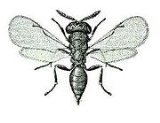
Eurytomidae
Encyclopedia
Eurytomidae is a family within the superfamily Chalcidoidea. The group is apparently polyphyletic, though the different subfamilies may each be monophyletic, and may be elevated to family status in the near future. As presently defined, there are some 1420 described species in 87 genera.
Unlike most chalcidoids, the larva
e of many are phytophagous (feeding in stems, seeds, or gall
s), while others are more typical parasitoid
s, though even then the hosts are usually found within plant tissues. They are found throughout the world in virtually all habitats, and a few are considered pests.
They tend to be dull and non-metallic, heavily punctured, with a very thick, collar-like pronotum, but none of these characters is unique within the Chalcidoidea, nor do they appear to define a natural group, and the family is likely to be divided up.
Unlike most chalcidoids, the larva
Larva
A larva is a distinct juvenile form many animals undergo before metamorphosis into adults. Animals with indirect development such as insects, amphibians, or cnidarians typically have a larval phase of their life cycle...
e of many are phytophagous (feeding in stems, seeds, or gall
Gall
Galls or cecidia are outgrowths on the surface of lifeforms caused by invasion by other lifeforms, such as parasites or bacterial infection. Plant galls are abnormal outgrowths of plant tissues and can be caused by various parasites, from fungi and bacteria, to insects and mites...
s), while others are more typical parasitoid
Parasitoid
A parasitoid is an organism that spends a significant portion of its life history attached to or within a single host organism in a relationship that is in essence parasitic; unlike a true parasite, however, it ultimately sterilises or kills, and sometimes consumes, the host...
s, though even then the hosts are usually found within plant tissues. They are found throughout the world in virtually all habitats, and a few are considered pests.
They tend to be dull and non-metallic, heavily punctured, with a very thick, collar-like pronotum, but none of these characters is unique within the Chalcidoidea, nor do they appear to define a natural group, and the family is likely to be divided up.
External links
- Universal Chalcidoidea Database
- Cedar Creek Pinned specimen images.

